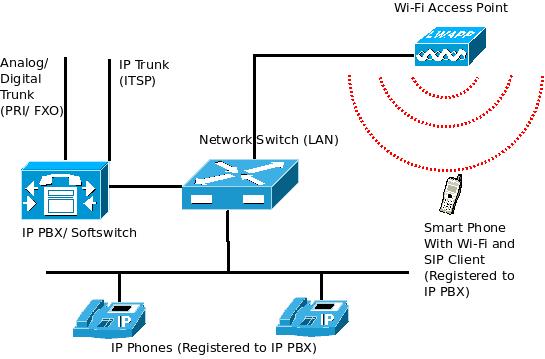Receive your PBX land line calls through SIP clients on Wi-Fi enabled Cell phones
There are many advantages of moving over to VOIP / IP Telephony. One of them, is the ability to receive your land line calls (Corporate PBX extension number) on your cell phones (smart phones) through the Wireless (Wi-Fi) Network. A software called SIP Client (If your IP PBX supports SIP) needs to be installed on the smart phone for this purpose. Let us find out more about this, in this article.
 The above diagram shows a basic IP PBX set up. LAN, is represented by a network switch (in the center). The IP PBX (or IP SoftSwitch) connects to the LAN (from the left) & also connects to both analog trunk lines (FXO /PRI Trunks) and IP Trunks (ITSP) through which the users can call the outside world. There are also some IP Phones (shown on the bottom) that connect to the LAN (through network switches) and gets registered to the IP PBX as extensions.
The above diagram shows a basic IP PBX set up. LAN, is represented by a network switch (in the center). The IP PBX (or IP SoftSwitch) connects to the LAN (from the left) & also connects to both analog trunk lines (FXO /PRI Trunks) and IP Trunks (ITSP) through which the users can call the outside world. There are also some IP Phones (shown on the bottom) that connect to the LAN (through network switches) and gets registered to the IP PBX as extensions.
There is also a Wireless (Wi-Fi) Access Point that connects to the network switch (LAN) for enabling wireless (wi-fi) network access. And finally, there is a cell phone (smart phone) that connects to the Wi-Fi network (and hence LAN) through a built-in Wi-Fi adapter.
If this cell phone can be loaded with a SIP Client, it can also get registered to the IP PBX as an extension. SIP Client, is a software that can be downloaded from the Internet for most of the Wi-Fi based Cell Phones (If it is supported by the cell phone/PBX manufacturer). Sometimes, the IP PBX manufacturers make the SIP Client available to some leading brands/models of cell phones by themselves – Especially, if an IP PBX uses a proprietary protocol (Other than SIP).
For an Open Source based IP PBX like Asterisk, there are quite a number of SIP clients available for various smart phone models.
So, when the SIP Client is installed on to a Smart Phone & connected to the corporate Wireless Network, it could be registered with the IP PBX as an extension. So, from the normal land line IP Phone, you could communicate with the smart phone over the Wi-Fi network by just dialing the extension number. Similarly, you could call out (using the trunk lines attached to the IP PBX) by dialing the phone number you want to reach – The IP PBX will select whether to route the call over an analog/ digital / IP trunk. You can also receive land line calls on your cell phone.
It is to be noted here that the land line calls are received on the cell phone using the Wi-Fi network and not the cellular network. So, you should decide whether you want to dial out any call using the Wi-Fi network, or the cellular network when you are in the office. Of course, you can receive calls that come from both land line (IP PBX through Wi-Fi network) or the Cellular network.
The main advantage of having a set up like this is the fact that you could receive your land line calls where ever you are in the office on your cell phone (Provided that the Wi-Fi network coverage is present in that area). There might not be a requirement for a Wired IP Phone on your desk, as you are receiving all your land line calls on the cell phone. So, at least for some users, there might not be a need to buy separate IP Phones. But do note that the SIP clients may be charged by some vendors. For open source IP PBX, its mostly free provided the phone supports it.
Its even possible to roam across the office while you are attending that land line call with your cell phone (This requires the Wireless Network to support roaming. So, a wireless controller needs to be used to enable roaming on all the wireless access points).
You can also use the 3G/4G network to connect the cell phone to Internet and use the SIP client to make outgoing calls through an ITSP – Internet Telephony Service Provider. But, in this case, the calls go through the Internet and not your company IP PBX. So, unless you have a direct corporate account with an ITSP, the calls will be charged to you.
The next step to making and receiving land line calls on your cell phones, is Fixed Mobile Convergence. This technology is basically about transferring a call between your Wi-Fi network and cellular network (and vice versa), with out disconnecting it! So, when you are moving out of the office, the call gets automatically transferred to your cellular network, without you having to disconnect the line!
excITingIP.com
You could stay up to date on the various computer networking/ related IT technologies by subscribing to this blog with your email address in the sidebar box that says, ‘Get email updates when new articles are published’
goodone
Document very well presented. i tried this with our open source IPBX system but i had problems of one way comunication and no communication at all even if the Mobile client was associated in the IPBX. what could be the problem?